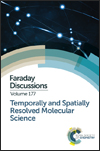Resolution enhancement through microscopic spatiotemporal control
Abstract
Operating at biologically benign conditions, multi-photon fluorescence imaging microscopy has benefitted immensely from recent developments in microscopic resolution enhancement. Fluorescence microscopy continues to be the best choice for experiments on live specimens, however, multi-photon fluorescence imaging often suffers from overlapping fluorescence of typical dyes used in microscopy, limiting its scope. This limitation has been the focus of our research where we show that by making simple modifications to the laser pulse structure, it is possible to resolve these overlapping fluorescence complications. Specifically, by using pairs of femtosecond pulses with variable delay in place of single pulse excitation, we show controlled fluorescence excitation or suppression of one of the fluorophores over the other through wave-packet interferometry. Such an effect prevails even after the fluorophore coherence timescale, which effectively results in a higher spatial resolution. Here we extend the effect of our pulse-pair technique to microscopic axial resolution experiments and show that such pairs of pulses can also ‘enhance’ axial resolution.
- This article is part of the themed collection: Temporally and Spatially Resolved Molecular Science

 Please wait while we load your content...
Please wait while we load your content...